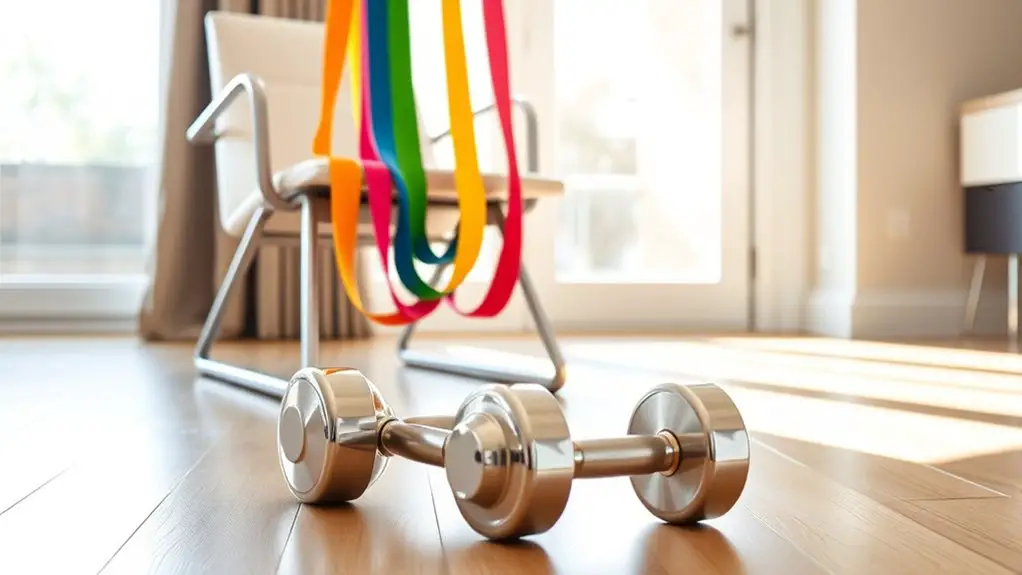Dumbbells vs. Resistance Bands: Which Is Better for Home Workouts?

When it comes to home workouts, it really depends on your goals. Dumbbells are great for building muscle and provide straightforward progressive overload. They allow for a wide range of traditional lifts. On the other hand, resistance bands are portable, budget-friendly, and lower risk for injuries. They offer varied resistance and are easy to adjust for different fitness levels. Explore the pros and cons of each option to find out which one best suits your routine.
Overview of Dumbbells

Dumbbells are a versatile and effective tool for strength training at home. With various dumbbell types available, like adjustable or fixed-weight options, you can easily find what’s best for your fitness level and space. When using dumbbells, focus on proper form to guarantee safety and prevent injuries. Incorporating a variety of workout techniques, such as curls, presses, and rows, allows you to target multiple muscle groups effectively.
Start with lighter weights to master your form before progressing to heavier dumbbells. It’s essential to listen to your body; if you feel any discomfort, don’t hesitate to adjust your technique or weight. Always warm up before your workout and consider cooling down afterward to aid recovery. By understanding the different dumbbell types and employing safe workout techniques, you’ll maximize your strength training benefits while minimizing the risk of injury.
Advantages of Dumbbells
Dumbbells offer a range of versatile exercise options that can target various muscle groups effectively. You can easily increase the weight as you progress, allowing for continuous muscle strength improvement. With their straightforward design, dumbbells make it simple to incorporate challenging workouts into your routine.
Versatile Exercise Options
When it comes to versatile exercise options, few pieces of equipment can match the adaptability of dumbbells. You can easily incorporate them into your routine, whether you’re doing bodyweight exercises or creating hybrid workouts that blend strength and cardio. With dumbbells, you can target various muscle groups safely and effectively, allowing you to progress at your own pace. Plus, they’re great for enhancing stability and coordination, which is key for preventing injuries. You can perform a wide range of movements, from squats and lunges to chest presses and rows, making them suitable for any fitness level. So, if you’re looking to add variety and challenge to your home workouts, dumbbells are a smart choice.
Progressive Weight Increase
One of the standout benefits of using dumbbells is the ability to progressively increase weight as you gain strength. This progressive resistance allows you to challenge your muscles safely and effectively. Here are three advantages to take into account:
- Incremental Load: You can easily adjust weights in small increments, helping to prevent injury while ensuring consistent progress.
- Customizable Workouts: With various weights available, you can tailor your workout to your fitness level, promoting safer training.
- Enhanced Tracking: Tracking your progress with dumbbells is straightforward; you can see how much weight you’ve lifted over time, which can motivate you to keep going.
Enhanced Muscle Strength
While both dumbbells and resistance bands can enhance your fitness routine, dumbbells offer unique advantages for building muscle strength. When you’re aiming for muscle hypertrophy techniques, dumbbells allow you to precisely control the weight you lift, making it easier to progress safely. This precision helps you maintain proper form, reducing the risk of injury. Additionally, incorporating a variety of dumbbell exercises can enhance your strength training frequency, promoting continuous muscle growth. As you gradually increase the weight, you’ll challenge your muscles consistently, leading to better results over time. Ultimately, if you prioritize effective muscle strength development in your home workouts, dumbbells are a solid choice that aligns well with your safety and fitness goals.
Overview of Resistance Bands
Resistance bands have become a popular choice for home workouts, offering versatility and convenience in a compact form. They’re lightweight, easy to store, and can provide effective resistance training without the bulk of weights. Understanding the different band types and resistance levels can help you choose the right bands for your fitness journey.
Here are three key points to contemplate:
- Band Types: Resistance bands come in various types, including loop bands, tube bands, and therapy bands, each suitable for different exercises and fitness levels.
- Resistance Levels: Most bands are color-coded to indicate resistance levels, which range from light to heavy. This allows you to progress safely as you build strength.
- Safety Tips: Always check for wear and tear before use, and verify you secure the bands properly to prevent snapping during workouts.
Incorporating resistance bands can enhance your home workout routine effectively and safely.
Advantages of Resistance Bands

When it comes to home workouts, resistance bands offer a unique set of advantages that make them an excellent choice for fitness enthusiasts of all levels. Their band durability guarantees you can rely on them for long-term use without worrying about wear and tear. Plus, they come in various resistance levels, allowing you to easily adjust your workout intensity as you progress.
Here’s a quick comparison of resistance bands’ advantages:
| Advantage | Description | Safety Aspect |
|---|---|---|
| Versatility | Can target multiple muscle groups | Low risk of injury |
| Portability | Lightweight and easy to store | Safe for all environments |
| Cost-Effective | Generally cheaper than weights | Budget-friendly option |
| Adjustable Levels | Change resistance easily | Customize workouts safely |
With resistance bands, you can achieve an effective workout while guaranteeing safety and convenience.
Comparing Effectiveness for Strength Training
When it comes to strength training, you might wonder how dumbbells and resistance bands stack up against each other. Each tool offers unique benefits, from muscle activation differences to the potential for progressive overload and versatility in exercises. Understanding these factors can help you choose the best option for your home workouts.
Muscle Activation Differences
While both dumbbells and resistance bands offer unique advantages, their impact on muscle activation can vary considerably during strength training. Understanding how these tools affect muscle recruitment and activation patterns is essential for your safety and effectiveness.
- Dumbbells: They typically promote higher muscle recruitment due to their ability to provide constant resistance throughout the movement, enhancing strength gains.
- Resistance Bands: These allow for varied activation patterns, as they create more tension at the peak of the movement, which can help target specific muscles effectively.
- Combination Use: Integrating both can optimize muscle activation by leveraging the strengths of each tool, ensuring you engage various muscle groups safely.
Choosing the right tool based on your goals can lead to improved workout results and better safety practices.
Progressive Overload Potential
To build strength effectively, understanding the potential for progressive overload with both dumbbells and resistance bands is essential. Dumbbells offer straightforward progressive overload techniques, allowing you to easily increase the weight as you gain strength. This method promotes consistent resistance adaptation, ensuring your muscles are continually challenged.
On the other hand, resistance bands can also be effective, but the progression might not be as clear-cut. You can adjust the tension or use bands of varying thickness to achieve the same effect. However, it’s important to maintain proper form to avoid injury, especially when increasing resistance. Both options can be safe and effective for building strength, so choose the one that best aligns with your comfort and fitness goals.
Versatility and Range
Both dumbbells and resistance bands have unique strengths that cater to different workout preferences, especially regarding versatility and range. When it comes to strength training, consider the following:
- Exercise Variety: Dumbbells allow for a wide range of traditional lifts, while resistance bands offer unique movements that can target specific muscle groups.
- Workout Customization: Resistance bands come in various tensions, making it easy to modify exercises for your fitness level. Dumbbells can also be combined for more complex routines.
- Space Efficiency: Bands are lightweight and portable, perfect for small spaces. Dumbbells require more room but can provide greater stability for certain lifts.
Portability and Convenience
When it comes to home workouts, the choice between dumbbells and resistance bands often boils down to portability and convenience. If you’re tight on space or constantly on the move, resistance bands are your best bet. They’re lightweight, easy to pack, and offer travel-friendly weights, making them perfect for any environment. You can easily carry them in your suitcase or gym bag without worrying about added bulk.
On the other hand, dumbbells can take up more room and can be cumbersome to transport. While they’re great for strength training, their weight and size can limit your flexibility, especially if you want to work out in various locations.
Ultimately, if you prioritize compact workout gear that you can use anywhere, resistance bands are likely the way to go. They provide a safe, effective workout while ensuring you can easily fit them into your lifestyle.
Choosing the Right Option for Your Goals

Selecting the right equipment for your home workouts largely depends on your fitness goals. To make an informed choice, consider these key factors during your goal assessment:
- Strength Training: If your primary goal is building muscle, dumbbells may offer more versatility for heavier lifts and specific movements.
- Flexibility and Rehabilitation: If you’re focused on improving flexibility or recovering from an injury, resistance bands provide a safer, low-impact alternative that allows for a full range of motion.
- Workout Preferences: Think about how you enjoy exercising. If you prefer dynamic movements and varied resistance, bands might suit you better. If you like straightforward strength exercises, dumbbells could be the way to go.
Ultimately, choose the equipment that aligns with your goals and feels comfortable. Prioritize safety and enjoy your workouts!
Frequently Asked Questions
Can Beginners Use Both Dumbbells and Resistance Bands Safely?
Absolutely, you can use both dumbbells and resistance bands safely as a beginner! While dumbbells provide stability, resistance bands offer versatility. To guarantee safety, focus on beginner techniques like mastering form and starting with lighter weights or lower resistance. Always warm up before your workout, and consider seeking guidance from instructional videos or a trainer. Remember, it’s all about progressing at your own pace while prioritizing your safety and comfort.
What Are the Best Exercises for Each Option?
When considering the best exercises, you can’t go wrong with both options. For dumbbell exercises, focus on basics like goblet squats, shoulder presses, and bent-over rows to build strength safely. For resistance band exercises, try banded squats, chest presses, and seated rows to enhance flexibility and control. Always prioritize proper form and start with lighter weights or bands. That way, you can enjoy your workouts while minimizing the risk of injury.
How Do I Store Dumbbells and Resistance Bands at Home?
When it comes to storing your workout gear, think of it like organizing a library—everything has its place! For dumbbells, consider a sturdy rack or a designated corner to avoid accidents. As for resistance bands, use hooks or a storage bag to keep them untangled. Always factor in space considerations; you want easy access while ensuring safety. With smart storage solutions, you can create a tidy workout area that inspires you to stay fit!
Are There Specific Injuries That Favor One Over the Other?
When considering injury prevention and rehabilitation exercises, it’s important to choose the right tool. Resistance bands are often favored for their flexibility and lower impact, making them suitable for those recovering from injuries. They allow for controlled movements that can help strengthen without overloading the joints. On the other hand, dumbbells can be beneficial for building strength but may pose a risk if not used correctly. Always prioritize safety and consult a professional if unsure.
Can I Combine Dumbbells and Resistance Bands in My Workouts?
Why limit yourself to just one type of equipment? You can absolutely combine dumbbells and resistance bands in your workouts! This combination benefits you by adding workout variety, targeting different muscle groups effectively. By incorporating both, you can enhance resistance, improve stability, and reduce the risk of injury. Just make certain to start with lighter weights and bands to guarantee you’re maintaining proper form and safety throughout your routines.





